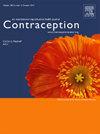左炔诺孕酮与铜质宫内节育器的紧急避孕效果评估。
IF 2.3
2区 医学
Q1 OBSTETRICS & GYNECOLOGY
引用次数: 0
摘要
目的:确定左炔诺孕酮52 mg和铜T380A宫内节育器(IUD)紧急避孕(EC)使用者的观察和预期妊娠风险。研究设计:这是一项二次分析,寻求EC的参与者被随机分配到左炔诺孕酮52 mg或铜T380A宫内节育器。参与者在入组前5天至少有一次无保护性交(UPI),并在前5天报告所有事件。我们报告了宫内节育器插入后1个月预期怀孕的比例,使用既定的方法,根据月经周期和性交日分配怀孕风险。我们计算了使用最近的UPI当天和所有报告的UPI在5天内预防怀孕的比例。结果:在接受左炔诺孕酮52 mg宫内节育器的312名参与者中发生了1例妊娠,137例(43.9%)报告了多次UPI发作。318名接受铜宫内节育器的参与者中没有发生妊娠,其中142名(44.6%)报告了多次妊娠。在左炔诺孕酮52 mg宫内节育器组中,14.8例妊娠预期使用最近一次UPI发作,22.0例妊娠预期使用出现后5天内所有发作。铜宫内节育器组预期妊娠分别为15.0例和23.1例。左炔诺孕酮52 mg宫内节育器的预期妊娠率为93.2% ~ 95.7%,铜宫内节育器的预期妊娠率为100%。结论:本分析结果提供了额外的数据,量化了在EC使用者的实际人群中左炔诺孕酮52 mg宫内节育器和铜宫内节育器的妊娠风险降低。意义:左炔诺孕酮52 mg宫内节育器用于紧急避孕,使用既定的妊娠风险方法预防93-96%的预期妊娠,而铜宫内节育器使用者的妊娠预防率为100%。本文章由计算机程序翻译,如有差异,请以英文原文为准。
Estimating emergency contraception efficacy with levonorgestrel and copper intrauterine devices
Objectives
This study aimed to determine observed vs expected pregnancy risk among levonorgestrel 52 mg and copper T380A intrauterine device (IUD) emergency contraception (EC) users.
Study design
This is a secondary analysis of participants seeking EC randomly assigned to a levonorgestrel 52 mg or copper T380A IUD. Participants had at least one episode of unprotected intercourse (UPI) in the 5 days preceding enrollment and reported all episodes in the preceding 5 days. We report the proportion of pregnancies prevented of those expected at 1 month following IUD insertion using an established approach that assigns pregnancy risk by menstrual cycle day of intercourse. We calculated proportion of pregnancies prevented using both the day of most recent UPI and all reported UPIs within 5 days of presentation.
Results
One pregnancy occurred among the 312 participants who received the levonorgestrel 52 mg IUD, with 137 (43.9%) reporting multiple episodes of UPI. No pregnancies occurred among the 318 participants who received the copper IUD, of whom 142 (44.6%) reported multiple episodes. In the levonorgestrel 52 mg IUD group, 14.8 pregnancies were expected using the most recent episode of UPI, and 22.0 pregnancies were expected using all episodes within 5 days of presentation. In the copper IUD group, we calculated 15.0 and 23.1 expected pregnancies, respectively. Levonorgestrel 52 mg IUDs prevented 93.2% to 95.7% of expected pregnancies, and copper IUDs prevented 100% of expected pregnancies.
Conclusions
The results of this analysis provide additional data quantifying the pregnancy risk reduction for both the levonorgestrel 52 mg IUD and copper IUD in a realistic population of EC users.
Implications
The levonorgestrel 52 mg IUD for emergency contraception prevented 93% to 96% of expected pregnancies using an established pregnancy risk method, while copper IUD users experienced 100% pregnancy prevention.
求助全文
通过发布文献求助,成功后即可免费获取论文全文。
去求助
来源期刊

Contraception
医学-妇产科学
CiteScore
4.70
自引率
17.20%
发文量
211
审稿时长
69 days
期刊介绍:
Contraception has an open access mirror journal Contraception: X, sharing the same aims and scope, editorial team, submission system and rigorous peer review.
The journal Contraception wishes to advance reproductive health through the rapid publication of the best and most interesting new scholarship regarding contraception and related fields such as abortion. The journal welcomes manuscripts from investigators working in the laboratory, clinical and social sciences, as well as public health and health professions education.
 求助内容:
求助内容: 应助结果提醒方式:
应助结果提醒方式:


